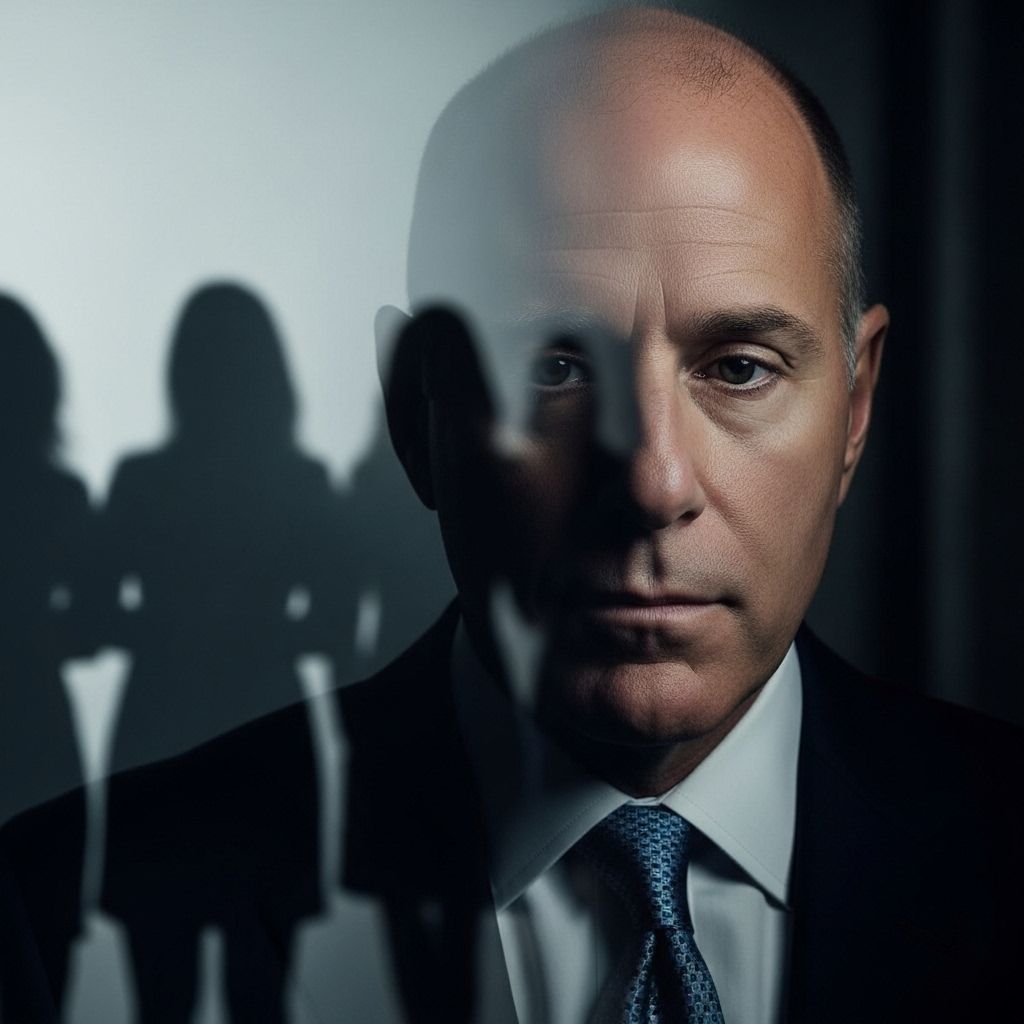Matt Lauer’s Troubling Relationship With Women: Hidden in Plain Sight
A deep dive into the allegations against Matt Lauer, the workplace culture at NBC, and the lessons on accountability and transparency.

Matt Lauer was once a fixture of American morning television, the beloved anchor of NBC’s Today show whose affable presence helped command millions of viewers for over two decades. But behind the warm persona lay a pattern of troubling behavior towards women—ignored, excused, or tolerated in the halls of media power—until the dam broke publicly with his 2017 firing over sexual misconduct allegations. This article examines Lauer’s downfall, the intricate details of workplace complicity at NBC, and lessons on the urgent need for institutional accountability.
Table of Contents
- NBC’s Star: Hiding in Plain Sight
- A Pattern of Troubling Behavior
- The Explosive Allegations
- The Role of Power and Silence
- NBC’s Culture of Complicity
- Public Reckoning and the MeToo Movement
- Workplace Accountability: Lessons Learned
- Frequently Asked Questions (FAQs)
NBC’s Star: Hiding in Plain Sight
Matt Lauer joined NBC’s Today show in 1994, quickly ascending to one of the most powerful positions in morning television. To colleagues and viewers alike, he was charismatic, urbane, and “safe.” For years, rumors circulated about his possible romantic entanglements with staffers, often as the subject of jokes (notably at the 2008 New York Friars Club roast, where his colleagues joked about his reputation for relationships with staff). These comments, while dismissed as playful jibes, hinted at a culture that tolerated problematic behavior just below the surface.
A Pattern of Troubling Behavior
Lauer’s relationship with female colleagues was marked by a clear pattern of boundary-crossing and inappropriate conduct. While few allegations were formally reported prior to 2017, whispers about Lauer’s predatory behavior persisted. Some staff members described him as flirtatious or even predatory—though this was often downplayed as simply part of the culture at NBC.
- 2000: Addie Zinone, a former Today production assistant, claimed a consensual but power-imbalanced relationship with Lauer. Zinone described feeling powerless to resist Lauer’s advances for fear it might hurt her career.
- 2010: Today show booker Melissa Lonner accused Lauer of exposing himself to her at an NBC event—a claim Lauer denied.
- 2014: During the Sochi Winter Olympics, a then-unidentified NBC staffer accused Lauer of sexual harassment that continued upon their return to New York.
Such incidents weren’t isolated; Variety and The New York Times later documented numerous allegations from at least ten current and former colleagues following Lauer’s firing. Many staffers reported a pattern of sexually charged comments, unwanted advances, and instances where Lauer allegedly used his position to exert control over vulnerable employees.
The Explosive Allegations: Brooke Nevils and Beyond
The most damning and widely publicized accusation came from Brooke Nevils, revealed in Ronan Farrow’s book Catch and Kill. Nevils claimed Lauer raped her in his hotel room during NBC’s coverage of the 2014 Sochi Winter Olympics. According to Farrow, Nevils felt forced to continue sexual encounters with Lauer out of fear for her career, characterizing these as “transactional” rather than consensual.
Upon release of Farrow’s book, Lauer vehemently denied the rape allegation, acknowledging a consensual affair but asserting the first encounter was not non-consensual. In his open letter to Variety, Lauer attempted to discredit Nevils, framing the situation as mutual and consensual while ignoring the power dynamic and the survivor’s account of impaired consent due to alcohol.
- Institutional silence: NBC managers claimed no knowledge of prior allegations before the 2017 complaint, yet former staff and investigative journalists alleged “everybody knew” about Lauer’s behavior and the risks he posed.
- Patterns of defense: Lauer’s response typified the ‘he said/she said’ framing that skews public perception and discredits victims.
The Role of Power and Silence
Central to the allegations against Lauer was the deep power differential between the anchor and his mostly young, female colleagues. The fear that rejecting advances would result in negative career consequences led to what Addie Zinone called an “abuse of power,” even when the encounters were technically consensual.
Lauer’s influence extended beyond personal relationships into NBC’s institutional culture. According to reporting by Ronan Farrow and others, Harvey Weinstein allegedly used NBC’s knowledge of Lauer’s misconduct to pressure the network into silencing a story on his own abuse, demonstrating how patterns of silence can enable more widespread wrongdoing.
NBC’s Culture of Complicity
Much of the reporting around Matt Lauer’s case focused not just on the individual but on NBC’s responsibility. Behind closed doors, NBC’s workplace culture appeared to accept inappropriate behavior as part of doing business. Farrow’s reporting, and subsequent stories in Variety, highlighted:
- Settlements and non-disclosure agreements (NDAs): NBC’s response often involved confidential settlements, gagging survivors from speaking about their experiences and perpetuating a cycle of silence.
- Lack of transparency: For years, NBC leadership failed to act or to disclose complaints meaningfully, despite knowing about pervasive rumors and even direct allegations.
- Protecting the brand: The priority was often preserving NBC’s reputation and profitability, no matter the cost to marginalized employees or survivors of misconduct.
The consequence was a workplace in which misconduct was effectively tolerated and survivors were discouraged from speaking out, fearing retaliation and professional harm.
Public Reckoning and the #MeToo Movement
Lauer’s firing came at the height of the #MeToo movement, a period marked by an unprecedented public reckoning for sexual misconduct across industries. While many survivors were finally able to voice their experiences, society also witnessed the rapid rehabilitation of powerful perpetrators; Matt Lauer himself predicted a return to television before new allegations surfaced.
But the #MeToo movement also exposed persistent cultural narratives that blame victims, question their motives, and seek to blur facts to protect institutional interests. Perpetrators often use alcohol strategically, both to undermine victims’ resistance and to challenge their credibility in the aftermath. This pattern emerged in Lauer’s case, with alleged survivors describing impaired consent and overwhelming fear of professional consequences.
Workplace Accountability: Lessons Learned
The lesson from the Lauer scandal is clear: accountability must go beyond individuals to the organizations that protect them. As Raliance notes, companies must create workplaces that are safer, healthier, and more equitable by:
- Implementing transparent policies: Clear, confidential reporting processes should empower survivors to speak out without fear of retaliation.
- Ensuring timely and appropriate responses: Institutions must investigate complaints thoroughly and impartially.
- Ending the cycle of silence: Non-disclosure agreements and settlements should not prevent survivors from sharing their experiences nor serve as tools to protect culpable parties.
- Cultural change: Accountability is not only about firing or disciplining wrongdoers, but about creating a culture where misconduct is unlikely to occur and impossible to tolerate.
Workplace Policy Table
| Policy Area | Best Practice | Potential Risks |
|---|---|---|
| Reporting Mechanism | Anonymous & confidential channels; easy accessibility | Fear of retaliation; lack of awareness |
| Investigation Procedure | Impartial, timely and transparent investigation | Bias, slow or token process |
| NDA Use | Limited, never used to shield wrongdoing | Silencing survivors; perpetuating abuse |
| Cultural Training | Regular anti-harassment, respect, and equity training | Outdated beliefs, superficial compliance |
Frequently Asked Questions (FAQs)
Q: Was NBC aware of Matt Lauer’s misconduct before 2017?
A: Although NBC managers initially claimed they only learned of allegations immediately before his firing, investigative reporting and accounts from multiple staffers suggest that Lauer’s inappropriate behavior was broadly known within the organization for years.
Q: What was the outcome for Matt Lauer after his firing?
A: Lauer was terminated in November 2017 “for cause” and did not receive a settlement. He attempted to mount a public defense of the more serious allegations but has not returned to television since.
Q: How did Lauer respond to the allegations of rape and sexual abuse?
A: Lauer denied nonconsensual encounters and disputed the survivor’s account in a public letter, but acknowledged a consensual extramarital affair. His defense has been criticized as victim-blaming and an attempt to leverage public sympathy.
Q: What key lessons should workplaces take away from the Matt Lauer scandal?
A: Institutions must design transparent and confidential reporting processes, respond appropriately and impartially to misconduct, and refuse to use NDAs or settlements to silence survivors. Cultural transformation is required to ensure workplaces are safe, equitable, and free from abuse.
Q: What impact did the Lauer scandal have on the broader #MeToo movement?
A: The scandal amplified the dialogue around institutional complicity and the need for real accountability, helping to shift public perception from mere punishment of individuals to demanding structural change across industries.
References
Read full bio of Sneha Tete












